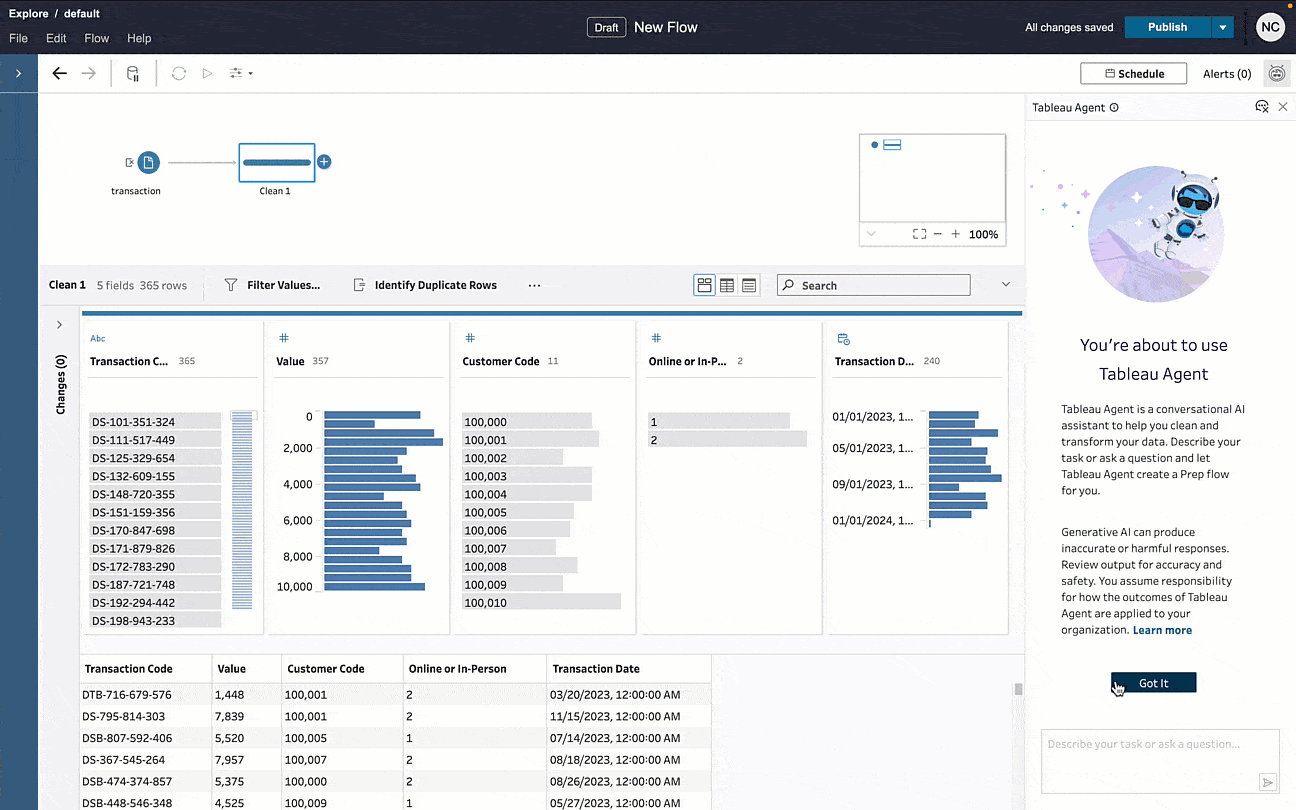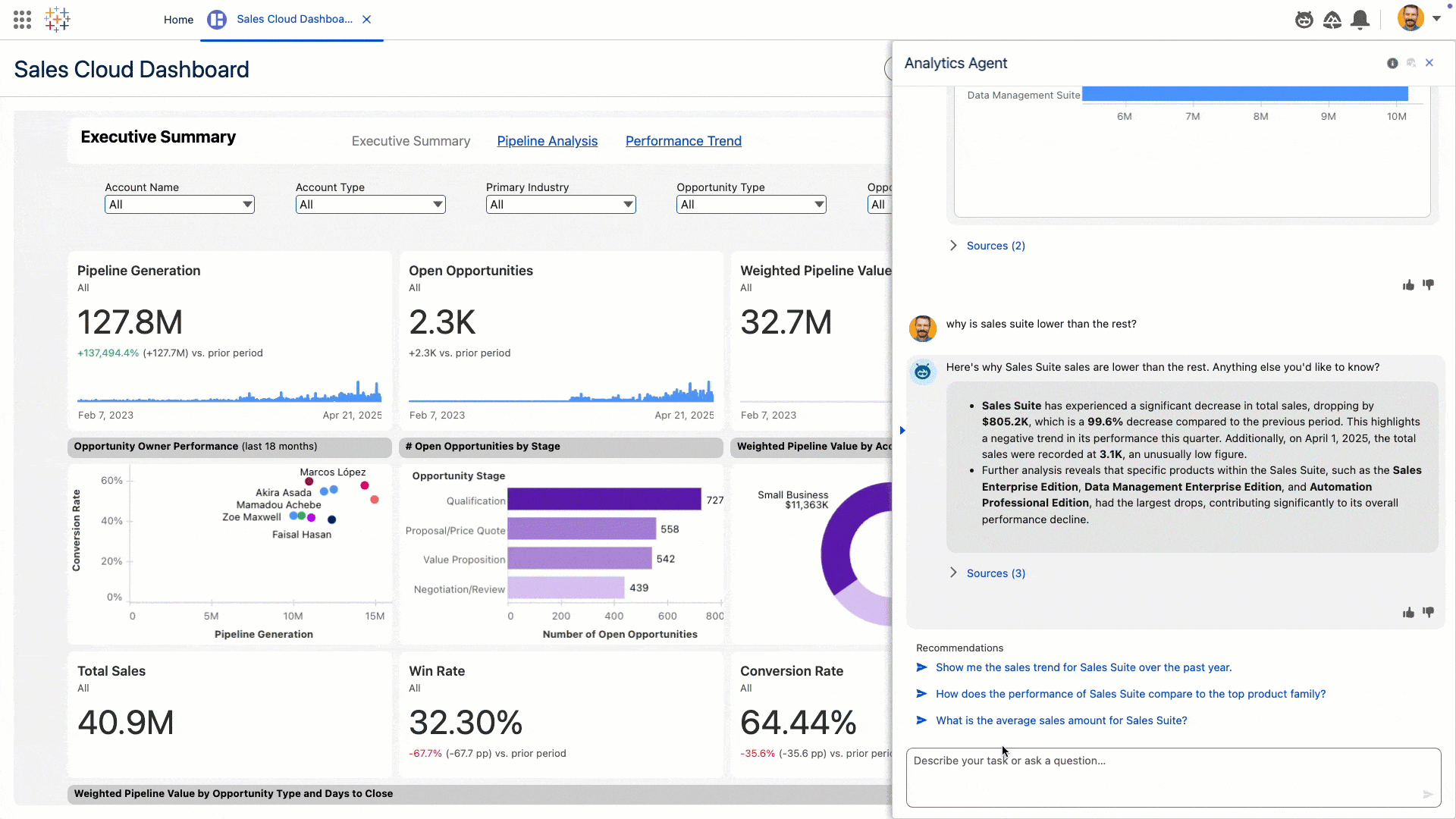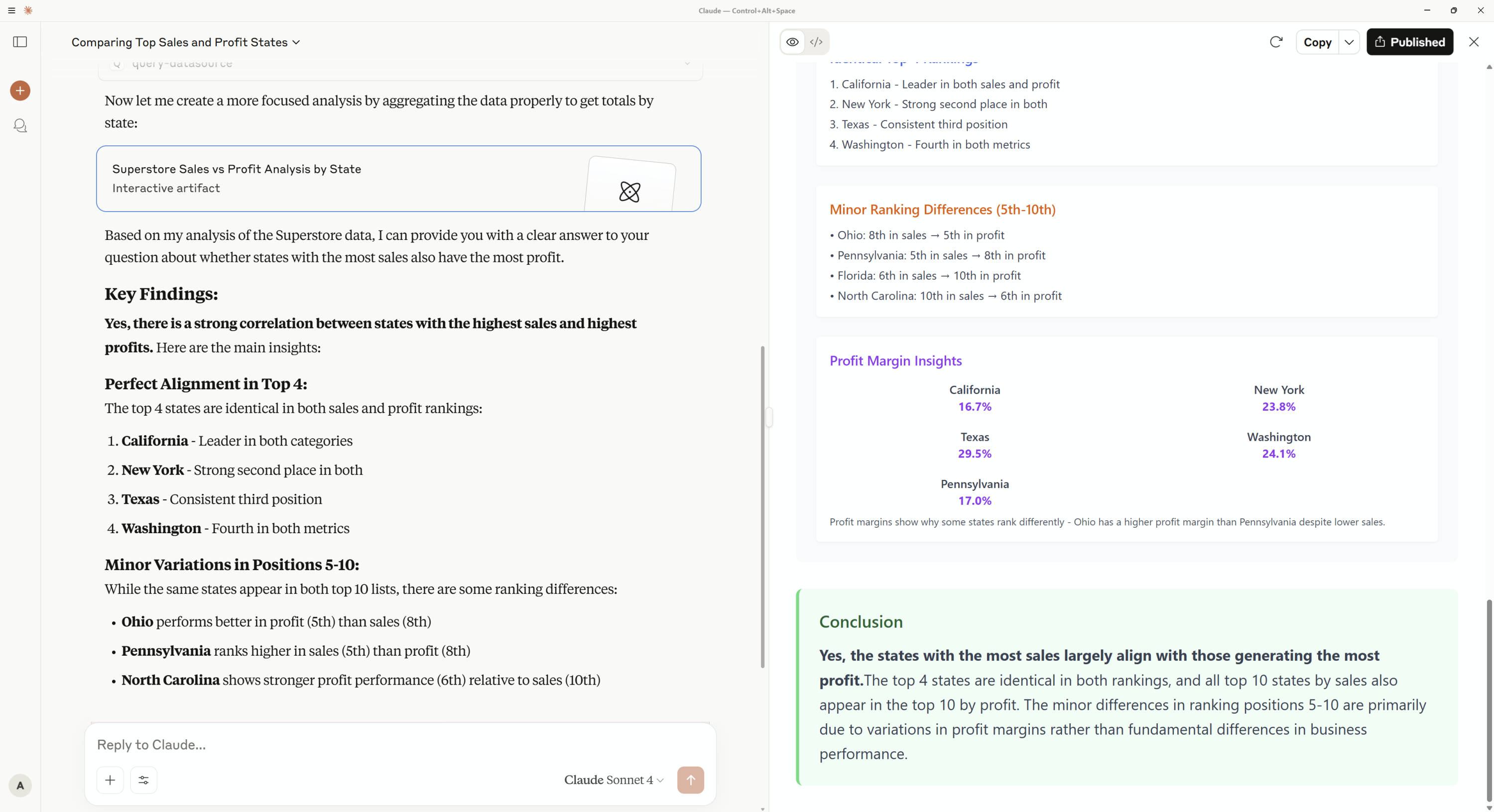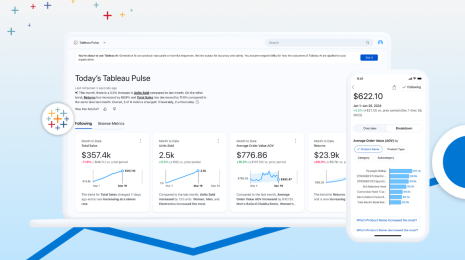Why Most ‘AI in BI’ Is Just a Gimmick—and How Tableau’s Approach to AI is Different
Every company is racing to become an "agentic enterprise"—where humans and AI agents collaborate seamlessly to drive business outcomes. But there’s a critical challenge that many overlook: AI is only as good as the data it uses. Without a foundation of trust and business context, AI initiatives risk delivering misleading answers, undermining the very decisions they’re meant to improve.
Too often, what others call artificial intelligence in business intelligence (“AI in BI”) is just a conversational veneer bolted onto a siloed data source. These tools create the illusion of intelligence but fail to deliver real value because they can't see the full picture. They are reactive, requiring endless prompting from the user, and they lack an open data foundation with a semantic layer to move from simply turning natural language into data questions to capturing the user’s context, understanding the business language, and proactively delivering insights and acting autonomously.
This generalized AI for BI approach falls short of the true potential of agentic AI to drive business outcomes. These solutions may offer an attractive demo but will often fail to close the critical gap between insights and action—in short, it's a gimmick.
At Tableau, our approach to AI in BI is designed to solve this foundational challenge and make your analytics more reliable, your teams more efficient, and your entire AI strategy more successful. We've long been committed to empowering everyone to see and understand their data so they can make smarter decisions. Over the years, we've fueled that commitment by integrating artificial intelligence across the entire Tableau platform, transforming how you interact with and get value from your data—and now we’re investing in even more AI innovation both in Tableau and for your own custom AI agents.
What is Tableau’s approach to AI?
Tableau has a comprehensive strategy to augment every stage of the analytics lifecycle with intelligent, AI-driven capabilities across the entire Tableau portfolio. Spanning Tableau Cloud, Tableau Server, and Tableau Next, the world’s first agentic analytics platform, AI in Tableau is not just a single feature—it's seamlessly integrated across the entire analytics experience.
Tableau’s built-in AI capabilities augment every stage of analysis from data to insight to action:
- Accelerate data prep: Analysts get assistance cleaning and mapping data, automating time-consuming processes to prepare data for analysis.
- Expedite semantic modeling: AI recommends proper semantics for your underlying data, using learning and context to help you create and maintain your critical semantic layer.
- Simplify complex analysis: AI-recommended questions jumpstart data exploration and help analysts move faster by turning natural language prompts into calculations and visualizations.
- Empower data consumption at scale: Business users get AI-powered insights directly in the flow of work and can dig deeper in natural language to drive smarter, faster decisions.
- Take action at the point of insight: AI will suggest follow-up questions—or even help take action on insights autonomously with predefined guidelines.
This is crucial to address the growing need for every company to become an agentic enterprise. As AI reshapes the way work gets done in this new era, confidence in decision making is more important than ever. Tableau’s AI capabilities allow businesses to move beyond traditional business intelligence towards more proactive, efficient decision making, ensuring that analytics is the core engine for longevity and growth.
How AI in Tableau works
Traditional business intelligence can be slow, complex, and manual, hindering the ability to get actionable insights. Tableau infuses intelligent assistance across every stage of the analytics journey to get from data to insight to action faster, including the ability to extend Tableau into your custom AI solutions.
Accelerate every stage of analysis with AI in Tableau
Supercharge your existing analytics workflows with built-in intelligence directly within the Tableau products your teams use every day.
For analysts
AI helps with automated data cleansing, and generating visualizations. In Tableau Prep, Tableau Agent guides you through complex data preparation with step-by-step instructions and helps create calculations. In Tableau Catalog, it quickly generates data source and table descriptions, automating a task that many analysts dread. And while authoring, Tableau Agent jumpstarts analysis with recommended questions and allows you to explore and visualize data conversationally.

With Tableau Agent, analysts collaborate with AI using natural language throughout every stage of analytics, helping them get to insights faster.
Tableau Next takes this further with Agentforce Tableau, a powerful suite of agentic capabilities for AI agents. For example, the Data Pro skill accelerates analytical workflows and accelerates semantic modeling by helping to create complex calculated fields from natural language prompts. It also includes built-in assistive AI to help suggest relationships and generate descriptions.
For business users and leaders
AI is infused into how you explore data and take action. Tableau Pulse reimagines analytics, delivering personalized metrics and insights directly into your workflow. This helps you stay on top of your business, find trends, and discover the "why" behind changes—all with AI-powered insights and conversational exploration.
With Agentforce Tableau in Tableau Next, the Concierge skill enables trusted data Q&A. Users can ask agents questions and receive detailed, accurate responses including interactive visualizations and sources. Additionally, the Inspector skill allows analytics agents to proactively monitor your data for insights with alerts for key metrics and changes in trends.

Concierge in Tableau Next enables trusted, on-demand conversational analytics for any user, including suggesting root causes and next-best actions, clarifying intent and ambiguity, and providing sources and reasoning behind answers.
Enhance your AI agents with analytics powered by Tableau
In the rapidly evolving world of agentic AI, you shouldn’t be locked into a single ecosystem. That’s why Tableau's approach is built on flexibility, allowing you to connect any AI model with Tableau’s powerful analytical engine. This integration is made possible by the Model Context Protocol (MCP), an open-source framework that acts as a universal bridge between your AI and Tableau. Tableau provides two open and secure MCP Servers with ready-to-use tools to simplify your AI development.
Tableau Next MCP allows you to integrate agentic analytics into your custom AI agent. You can convert complex analytics questions—for example, those requiring multivariate analysis or causal diagnostics—into actionable insights. Get accurate answers grounded in an AI-ready semantic layer and act on your data with confidence, since every interaction is secured by the Agentforce Trust Layer.

Tableau Next MCP enables trusted and advanced analytics capabilities with natural language interactions in your custom AI agents.
Tableau MCP, available for Tableau Cloud and Server, offers you the flexibility to supercharge your custom AI agents. Answer data questions by accessing your published data sources with VizQL Data Service, conduct governed and deterministic analytics through curated Pulse metrics, and even help your AI agents improve interpretation and explanations by leveraging Tableau's metadata to ground your AI models.
How Tableau’s approach to AI is different from other BI solutions
Tableau’s approach to AI analytics is different because of our two-sided AI strategy and deep integration across the entire Tableau portfolio—all built on a foundation of trust and governance.
- Two-sided AI strategy: Unlike solutions that offer AI as an add-on, we've seamlessly embedded AI into every part of the Tableau experience. Simultaneously, we provide an open framework with Tableau MCP that allows you to integrate Tableau's powerful analytics engine into your custom AI applications, giving you unmatched flexibility and control.
- Comprehensive portfolio integration: AI in Tableau is not limited to a single product. It's infused across Tableau Server, Tableau Cloud, and Tableau Next. This means you can deploy AI within your security boundary (Tableau Server), leverage a fully hosted AI-powered platform (Tableau Cloud), or embrace agentic analytics that can act autonomously (Tableau Next). This breadth of integration ensures that no matter where you are on your AI journey, Tableau has a solution for you.
- Analytics interoperability: Our interoperability strategy creates a cohesive environment that allows you to use the best AI-powered features of each tool (whether that’s Tableau Cloud, Tableau Server, or Tableau Next) on the same trusted data foundation. This means you can enhance the analytics assets you've already built in Tableau Server or Tableau Cloud—like Published Data Sources—to power the latest agentic AI capabilities from Tableau Next, all without disrupting your existing workflows
- Trust and governance: Trust is paramount when it comes to using AI with your data. Tableau’s approach to AI is designed with security and governance at its core, particularly with Tableau Next and Tableau Next MCP, which are protected by the Agentforce Trust Layer. This ensures that your data remains secure, safe, and accessible only as intended, allowing IT and data teams to observe and manage AI use. We enable you to bring your own LLMs and execute within your network boundary, providing ultimate flexibility and control over your data.
- Focus on actionable insights: Our AI capabilities are designed to do more than just provide an answer; they deliver true actionability. For business users, AI in Tableau surfaces intuitive explanations for data trends, explaining the drivers behind an insight to help make smarter, more confident decisions. Tableau’s AI also moves beyond assisting to acting autonomously on your behalf. With Tableau Next, agents have the business context to reliably answer questions and proactively provide insights, but also generate visualizations and take action, transforming insights into real business outcomes.
Your path to the agentic enterprise
The true value of AI is not just in answering questions, but in driving business outcomes smarter, faster, and more easily. Tableau delivers on this promise by providing a comprehensive AI strategy that enhances every stage of your analytics journey. From simplifying complex analysis in Tableau and delivering actionable insights to every user, to enabling your custom AI applications with trusted data, we provide the tools to make your entire organization more intelligent, efficient, and confident in data-driven decision making.
The future of analytics is agentic—and with Tableau, you are well-equipped to lead the way. Ready to take your next step?
- Explore the possibilities of AI in Tableau to discover how it can transform your business.
- See how our agentic analytics platform can transform your business with proactive, autonomous insights—check out Tableau Next.








